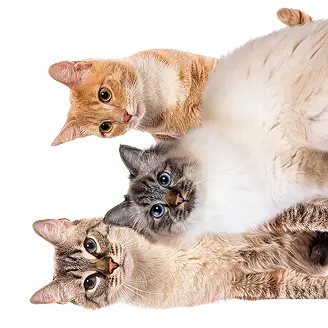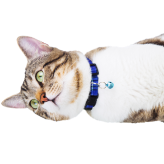Cat Breeds
Choosing a cat is not an easy task, as they are all so cute and fascinating. Therefore, it is important to pick your new furry friend according to their personality and needs because these criteria need to match your requirements. So, will you go for a giant cat or a fluffy cat? How about the hairless cat? Still don’t know? Find out all there is too know about 68 of the greatest cat breeds a-z. With the help of our experts, we are sure you will find your new feline friend.

-
 Abyssinian Cat
Abyssinian Cat
-
 American Bobtail
American Bobtail
-
 American Curl
American Curl
-
 American Shorthair
American Shorthair
-
 American Wirehair
American Wirehair
-
 Balinese cat
Balinese cat
-
-
 Bengal
Bengal
-
 Birman
Birman
-
 Bombay
Bombay
-
 British Longhair
British Longhair
-
 British Shorthair
British Shorthair
-
 Burmese
Burmese
-
 Burmilla
Burmilla
-
 California Spangled
California Spangled
-
-
 Californian Rex
Californian Rex
-
 Ceylon
Ceylon
-
 Chartreux
Chartreux
-
 Chausie
Chausie
-
 Chinchilla Persian
Chinchilla Persian
-
 Cornish Rex
Cornish Rex
-
-
 Cymric
Cymric
-
 Devon Rex
Devon Rex
-
 Domestic shorthair
Domestic shorthair
-
 Donskoy
Donskoy
-
 Egyptian Mau
Egyptian Mau
-
 European Shorthair
European Shorthair
-
 Exotic shorthair
Exotic shorthair
-
 German Rex
German Rex
-
-
 Havana Brown
Havana Brown
-
 Highland Fold
Highland Fold
-
 Himalayan
Himalayan
-
 Japanese Bobtail
Japanese Bobtail
-
 Javanese
Javanese
-
 Khao Manee
Khao Manee
-
-
 Korat
Korat
-
 LaPerm
LaPerm
-
 Maine Coon
Maine Coon
-
 Manx
Manx
-
 Munchkin
Munchkin
-
 Nebelung
Nebelung
-
 Norwegian Forest cat
Norwegian Forest cat
-
 Ocicat
Ocicat
-
-
 Oriental
Oriental
-
 Persian
Persian
-
 Peterbald
Peterbald
-
 Pixie-bob
Pixie-bob
-
 Ragamuffin
Ragamuffin
-
 Ragdoll
Ragdoll
-
-
 Russian Blue
Russian Blue
-
 Safari
Safari
-
 Savannah
Savannah
-
 Scottish Fold
Scottish Fold
-
 Selkirk Rex
Selkirk Rex
-
 Siamese Cat
Siamese Cat
-
 Siberian cat
Siberian cat
-
 Singapura
Singapura
-
-
 Snowshoe
Snowshoe
-
 Sokoke
Sokoke
-
 Somali
Somali
-
 Sphynx
Sphynx
-
 Thaï
Thaï
-
 Tiffany
Tiffany
-
-
 Tonkinese
Tonkinese
-
 Toyger
Toyger
-
 Turkish Angora
Turkish Angora
-
 Turkish Van
Turkish Van
-
 York Chocolate
York Chocolate
The following breed sheets will describe in detail, both in a physical and behavioural aspect, the most popular cat breeds in the UK. From the small cat breeds, to the big cat breeds, whether you’re looking for a barn cat, an apartment cat, or just a family cat, read on to find your match made in heaven. These breed sheets are primordial if you’re thinking of buying or adopting a cat. You must think about the type of cat you’re looking for and find a breed that matches these criteria. This descriptive list of cat breeds a-z can be a start in your research.
Where do cats come from?
All breeds of domestic cats can be traced back to one common ancestor : the African Wildcat. Archaeological discoveries have led scientists to believe that the domestication of this species first originated in Egypt and the Near East. The first domesticated cats had stripes; other colour varieties only started to appear during the Middle Ages. Cats were domesticated much later than dogs, hence their more independent relationship with humans. Indeed, dogs were useful to Man even back when they were nomadic hunters, whereas cats only became useful once Man began to settle down and needed little felines to chase pests off their farmland. People obviously favoured cats with more docile traits, and these cats began to adapt to their new home environment. Over time, humans have selected for very specific traits in order to create breeds that could suit every kind of personality. For instance, some cats have been bred to have longer coats or flatter faces to intensify their cute factor, while others have been bred to keep their active side in order to suit more lively owners. In this way, humans have been able to produce the dozens of breeds of house cats that we know today.
What different cat breeds exist and how many are there?
To neatly organise and keep track of all these cat breeds, ‘clubs’ have been created all over the world.
GCCF (The Governing Council of the Cat Fancy), is the UK’s premier registration body when it comes to classifying cat breeds. As cats were not necessarily bred for specific purposes but rather for Man’s preferences in physical and behavioural attributes, there is not a large variety of breeds. GCCF recognises 40 different cat breeds, of which the most popular currently is the British Shorthair. However, the list of breeds can largely depend on which organisation you’re getting your information from. For instance, the CFA (Cat Fancier’s Association), the USA’s cat registration body, recognizes 44 breeds, and the FIF (Federation Internationale Feline), with member organizations in 40 countries, recognizes 48 breeds.
A pure-bred cat is a cat whose standardised breed is not only registered to a club, but who also has a pedigree, that is, a lineage of ancestors all belonging to this same breed.
However, about 98% of cats fall outside of the pure-bred category. They are sometimes mistakenly called ‘mixed-breeds’, which is misleading since these cats usually don’t have any pure-bred cats in their family trees at all. More accurately, they can be called domestic shorthairs or domestic longhairs. These are not recognised as official breeds.
With such few pure-breeds actually registered, cat breeds are not classified into different groups like dogs are.
How do I choose my cat?
There are evidently less cat breeds to choose from than there are dog breeds, but this does not mean that the decision on which one to adopt should be any less thought through. Various breeds display various characteristics, some which may be more suited to your lifestyle than others. Some cat breeds will need a lot of meticulous grooming, some would rather chase mice in a garden rather than snuggle up on your lap, and some will vocalise non-stop until your upstairs neighbours can’t take it anymore. So make sure you choose wisely! Cats are also very long-term companions, and if well-cared for, can live from 12 to 20 years! They are, like all pets, time-consuming and also a major financial commitment.
Choosing a specific breed will be more useful for people who are looking for a very specific trait to match their lifestyle – a laid back cat to match an apartment life, or a friendly one to match a family-oriented life, for instance. However, if you’re just looking to complete your home with any cat, and are not too worried about the predictability factor, you should also consider adopting a domestic short/long hair. Cats are cats, and most of their behavioural traits (purebred or not) will depend on how they are treated and what kind of lifestyle they are being offered.
Check out the following cat breeds a-z to aid you in your research. If you are looking for a specific breed, however, keep in mind that just like humans, cats are individuals, and everyone of them is unique in their own way!
Once you’ve chosen your cat and brought it home, treasure their presence in your life, for it is truly like no other!


